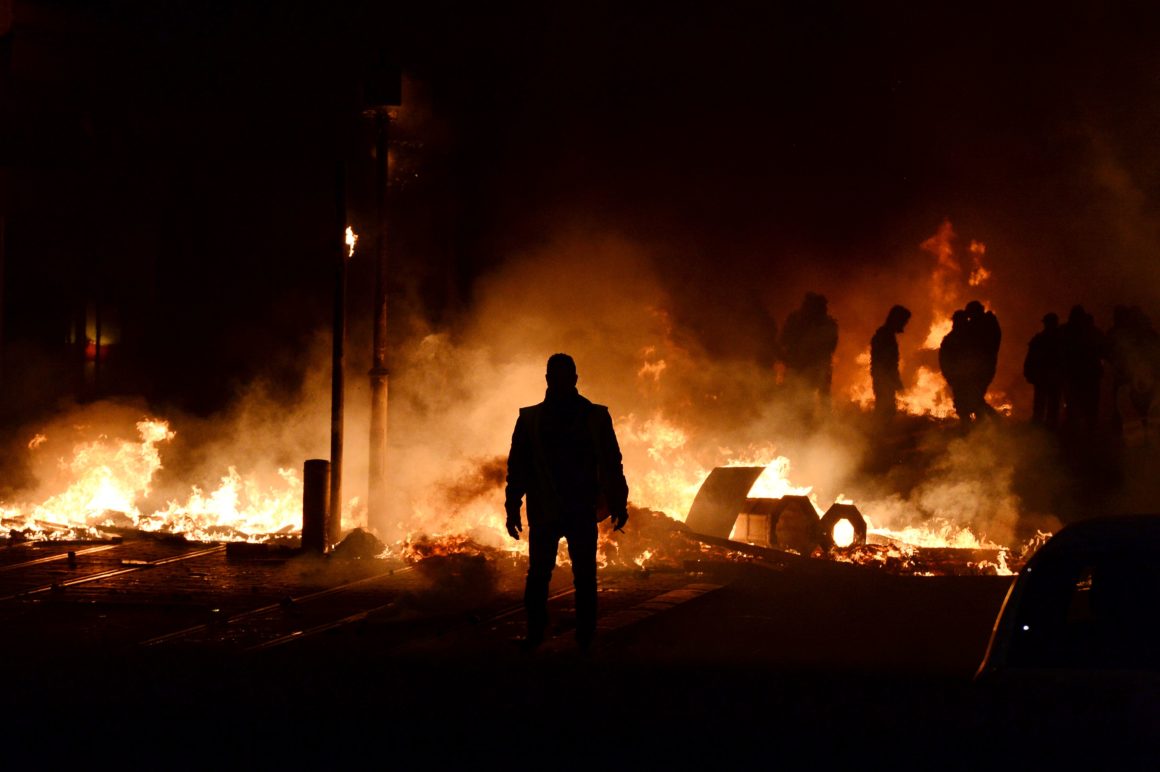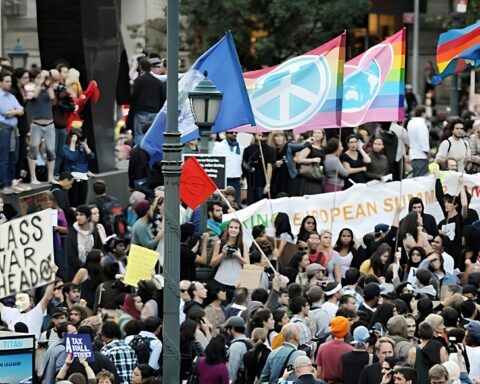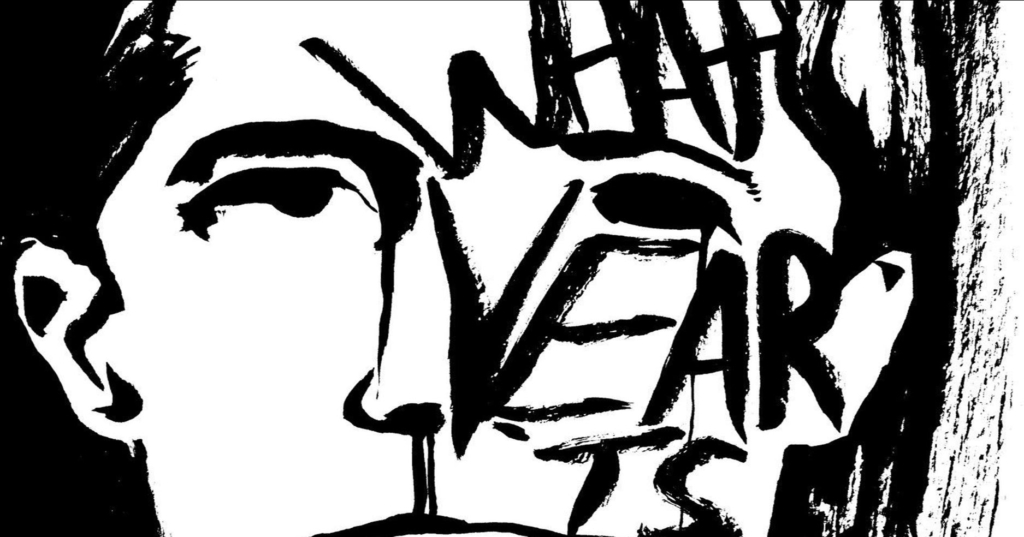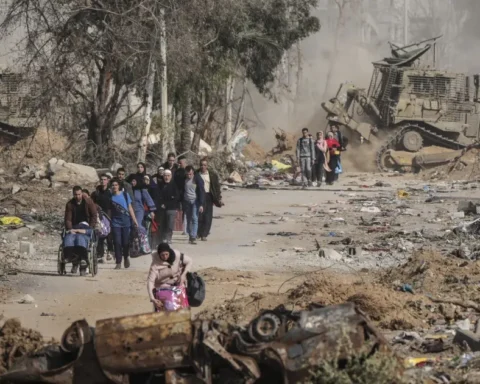Ιnterview conducted on September 12, 2019 by ACTA, on the occasion of the publication of Baschet’s new book on the Gilets Jaunes uprising, Une Juste colère. Interrompre la destruction du monde
1. I would like to begin by asking about the title of your book, or rather, its subtitle: “interrupting the destruction of the world.” Since the 19th century, and for quite some time, the tradition of the communist movement has thought of revolution as, in Marx’s words, a “locomotive of history.” In other words, that human emancipation was somehow inscribed in historical development itself. Walter Benjamin reversed this formula, suggesting that revolution would rather be “the act by which humanity aboard the train applies the emergency brake.” You seem to be more in line with this latter filiation. What are the issues at stake for you of such a paradigm shift? And how are they linked in particular to the current ecological disaster?
Jérôme Baschet: I’m quite happy to accept your Benjaminian reading of the subtitle. Let me add something about the term “destruction,” which seems to me to be characteristic of a third age of the critique of capitalism. If the first age focused on exploitation, and the second on alienation, the third now focuses on destruction. Although it was certainly anticipated here and there, this shift in dimension is now clearly becoming dominant, as ecological devastation – in the broad sense of Guattari’s three ecologies – now comes to the fore. This does not mean that the other dimensions of critique – and the other aspects of capitalist domination they pointed to – are somehow invalidated; they must simply be reformulated in a new context where capitalist barbarism reaches such a degree that the very possibility of life on Earth is potentially called into question.
“Interrupting the destruction of the world,” then—although I might as well have said, even if the wording may seem strange, “interrupting the world of destruction.” For it is indeed a question of interrupting the course of this world of destruction, which crushes and annihilates so many manifold worlds. To interrupt the destruction of the world, in short, can only mean ending the world of destruction. And this world is the world of the Economy – a world dominated by economic tyranny and animated by a productivist compulsion that is the direct source of the present ecological and human devastation.
This insight implies a “paradigm shift” in our conception of the revolution and, more broadly, of historical time. It has recently been said that there is a major cleavage within the thought of emancipation. For some, it is necessary to preserve, or rediscover, the classical parameters of modernity, and in particular a conception of History understood as a triumphant advance of Progress. It certainly seems increasingly difficult to uphold such an image; yet some persist, in spite of every obstacle, in pushing this line, defending “accelerationist” theses according to which, to exit capitalism, it is necessary not only to continue “in the direction of history,” but even to move as fast as possible by intensifying the most advanced technological and organizational characteristics of capitalism. Full speed ahead, comrades! On the other side of the dividing line are all those who, following Benjamin, consider that we must completely abandon an untenable modern-progressive conception of history. To the arguments that Benjamin put forward in 1940, many others have since been added; and today it is ecological destruction that visibly and dramatically transforms the glorious march of Progress into a mad dash towards the abyss.
All this has important implications for the way in which a possible revolutionary process is conceived, but also, more broadly, for the relationship between present and future, or between past and future. We no longer have History on our side; we are no longer messengers on behalf of any sense of History that would inexorably lead us to salvation. There is a whole swath of representations wrapped up in this that need to be overcome, many of which have been highly effective at the level of organization, even if it is easy these days to recognize their fictitious and illusory nature. But it also means that another vision of history, of collective action, and of the intertwining in the present of the living memory of recollected pasts and the anticipation of possible futures, must be entirely invented.
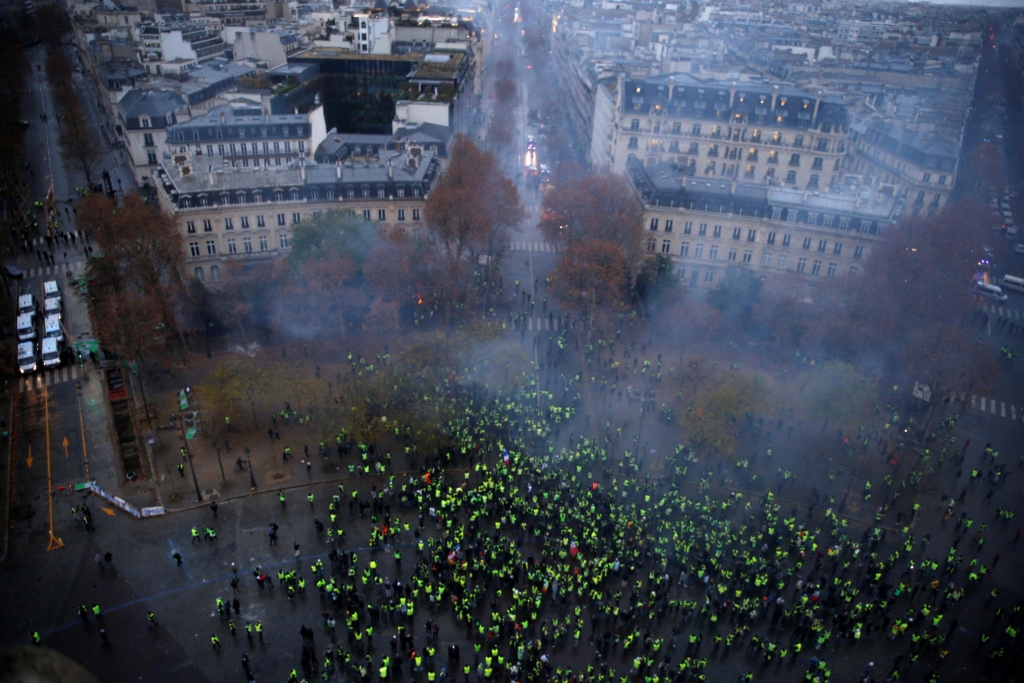
2. Let’s turn now to the Yellow Vest movement, and your book about it. You insist that an essential trait that characterizes the movement lies in its refusal of representation, the refusal to be “recuperated by politicians” and normalized by the classical forms of politics. It is certainly striking to observe that, whereas many if not most of the mass movements of the previous cycle of struggle paved the way for parliamentary parties claiming to embody their “political outlet” (Podemos in Spain, Syriza in Greece) yet producing only renewed forms of social democracy, the Yellow Vests have so far deviated from the rule. How should we explain this? Whence this deeply rooted refusal of political representation and traditional parliamentary games?
The Yellow Vests uprising has blown apart the frameworks of classical politics, based as it is on the principle of representation, whose center of gravity turns around political parties locked into electoral competitions over control of the State apparatus. Of course, we have seen the inverse tendency too, here and there, with people attempting to play the role of spokespersons for the movement, acting as self- proclaimed negotiators with the government. There have been attempts by far-right or left-wing militants to infiltrate and steer the movement. But what has been most impressive is the collective intelligence deployed by the various groups of Yellow Vests, most often successfully, which has detected all of this and prevented the takeover of the movement by political sects or trade union activists. The more militant leftist characters that have been allowed to move among the Yellow Vests have generally only been able to integrate provided they abandon their usual speeches and attitudes and adapt to a collective dynamic that breaks with the parameters of classical politics.
No one can predict what will happen, but it is unlikely that parties such as Podemos will manage to assert themselves in France as a “political outlet” for the Yellow Vests uprising. On the other hand, the preparation of the 2020 municipal elections could be an opportunity to rebound on some of the concerns expressed by the Yellow Vests. If it were then a question of entering into the game of classic politics, for example by integrating candidates branded as “yellow vests” among the lists of parties or personalities already in place, this would not make any more sense than the anecdotal lists that emerged during the
European elections. Conquering town halls and then claiming to develop forms of participatory democracy would also have obvious limitations and would only superficially modify the frameworks of classical politics. On the other hand, the municipal elections could offer a pretext to relaunch the formation of popular assemblies at the county or district-level, which could take charge of the organization of certain aspects of community life. In the event that they had the strength, the Yellow Vests could try to seize municipal offices as a means to extend their capacity for action, while transforming the elected officials therein into mere executors of the decisions of the assemblies. Such a process would not be easy and would come with many risks. But we cannot a priori exclude the possibility that the local anchoring of the Yellow Vest movement and the concrete solidarity networks it has created may be consolidated and extended by taking advantage of the space opened locally by the municipal timeline. While this may seem paradoxical, it would not necessarily signal a return to classical forms of politics, provided that the focus and attention do not center on municipal administrations but rather on the popular assemblies, which could then engender genuine counter-powers.
3. I have a follow-up question: the Yellow Vests did not simply criticize representative democracy, but also experimented with the implementation of new forms of collective organization “from below,” in particular by multiplying so-called “popular assemblies.” According to you, the latter prefigure instances of self- government and echo other experiments in political emancipation both past (the Paris Commune) and present (Chiapas and Rojava, in particular). What connects these different experiences, and how are the Yellow Vests inspired by these other revolutionary sequences?
I think it’s important to underline the positive dimensions of the Yellow Vest uprising. At the same time as they have radically rejected classical politics — that is, politics from above, centered on state power, parties, the political class and “experts” in public affairs — they have also sought to experiment with another form of politics, which emerges from below, in situated places of life [lieux de vie] through the ability of ordinary people to organize themselves and begin making their own decisions. It is this rejection of the politics from above and this choice of this politics from below that creates a deep affinity between the Yellow Vest uprising and the other experiments you mentioned, such as the Paris Commune, Rojava, Chiapas, or others. This overlap seems highly important.
However, I don’t think it’s quite precise to claim that the assemblies that have emerged as part of the Yellow Vests movement ‘prefigure instances of self-government’. This is only one possible future, particularly if one takes into account the Call by the Commercy Yellow Vests to form popular assemblies everywhere, by means of which “to reclaim power over our lives.” But it would be an exaggeration to suggest that the assemblies of the Yellow Vests necessarily tend towards forms of self-government, as if this formed their natural horizon. As for the Paris Commune, Rojava, and Chiapas, these references have appeared sporadically, and it is fortunate that they have never been invoked as models, which they cannot be.
That said, if we seek to give a politics from below its full strength and to push it to the point where it would be able to destitute politics from above, then it is indeed appropriate — perhaps as part of a generalized movement of blockades — to initiate instances of popular self-government. In other words, instances of self-organized communal life. In this regard, it must be recognized that the Paris Commune and Zapatista autonomy are particularly inspiring experiences. The call by certain currents of the Yellow Vests to increase the number of popular assemblies could be one way — necessarily singular — of sketching such practices of popular self-government.
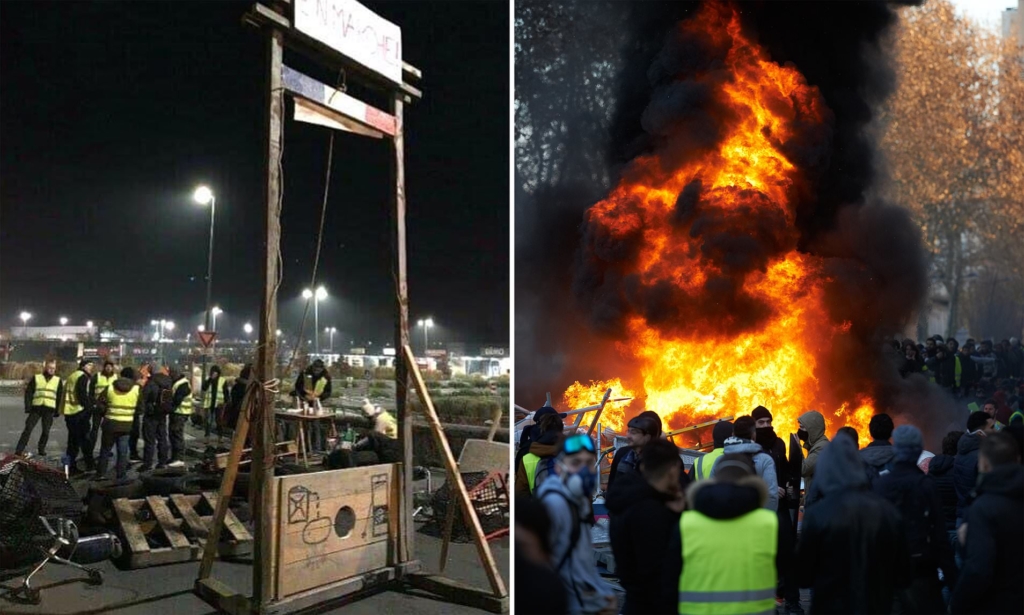
4. Another important aspect of the Yellow Vest movement has been the centrality of the blockade as a form of action. Today, as capitalism extends its domination beyond the productive sphere and tends to encompass all aspects of life, the strike seems insufficient by itself to sustain a real balance of power. Hence the necessity, as you indicate, that an “articulation of multiple struggles” take place, a coordination of different social subjectivities in accordance with a logic of “generalized dispossession.” Among other examples, the blockade of the Rungis logistics center has seen the emergence of a practical alliance between yellow vests and the more combative nuclei within the unions. Similarly, some organizations in working-class neighborhoods, such as the Adama Committee [against racist police violence in the suburbs] were quick to join the Yellow Vests and affirm their solidarity with the movement. How do you view these attempts at crossover, and does the next step depend on a possible strengthening of these alliances?
Such crossovers do indeed seem important to me, and to be able to give them more strength would certainly be decisive. I devoted a whole chapter of my book to the question of blockades, as it has been one of the central forms of action adopted by the Yellow Vests. From this point of view, I suggest that we attempt to expand this notion of blockage to include all of its possible dimensions, in the hopes that they might be combined, rather than seeking to oppose one to another. This includes blocking flows and infrastructures, i.e. the sphere of circulation (of people, goods, and the flow of information). But also the blocking of consumption (in addition to the axes of communication, the Yellow Vests have often targeted the distribution centers on which supermarket chains depend); blockades that develop inhabited territories directly in the path of large-scale, harmful, and useless megaprojects; blockades in the sphere of social reproduction (e.g., climate strikes by the younger generation, which call into question social reproduction, of which schools are only one vector among others), as well as blockades in the sphere of production itself, through strikes.
On this last point, it is obvious that the strike has lost the centrality it enjoyed throughout the history of the labor movement. First, because the reorganizations of the work world in the neoliberal age have done everything possible to make it less and less possible, and less and less effective. But also because the work world can no longer be considered as the only sphere — or even the sphere par excellence — in which the relations of domination that constitute capitalism are exercised. This domination goes far beyond work, and when it comes to producing docile citizens and avid consumers, it quickly penetrates the “free” time of leisure and consumption, permeates all aspects of life and moulds subjectivities trained to competition in an increasingly direct fashion, resulting in a cult of success oriented around the quantitative evaluation of everything. In the classical age of capitalism, it might have seemed like the Capital/Labor opposition condensed its fundamental antagonism — and again, this would still be to risk overlooking both gender domination and colonial domination, both of which were and remain essential to capital’s affirmation. In the age of neoliberal capitalism, without the question of labor or strikes disappearing entirely from our radar, the fundamental antagonisms of the world of economics must be rethought more broadly, to encompass the multiple modalities of the dynamic of generalized dispossession: the dispossession of the meaning of one’s work, accentuated by the insatiable pressure toward maximization; the relegation to social nonexistence through unemployment, precarity, and exclusion; despoliation of territories through the multiplication of infrastructural megaprojects and the acceleration of commodification; the impossibility of safety for women continually exposed to gender violence; the dehumanization and discrimination experienced by racialized populations; the curtailed enjoyment of a consumerism transformed into subjugation by the weight of debt; the pervasive feeling of political dispossession in the face of collapsing representative democracies; the dispossession of our experience of time by the tyranny of unending ‘emergencies’; not to mention the most serious of all: the ongoing ecological devastation that deprives us all of the possibility of a dignified life. On the one hand, then, there is antagonism, everything that contributes to our generalized dispossession, itself associated with pure and simple destruction; and on the other hand, everything that seeks to oppose it, in an ethical leap to save the possibility of a dignified life for all human and non-human inhabitants of the Earth.
It is this broad understanding of the multiple forms of dispossession induced by the world of economics that lends credence to a strategy based on intensifying blockades, understood in all their various forms. “Let’s block everything” is a perfectly sensible way of opposing the dynamics of capitalist domination and its extension across every domain of life. Finally, it should be stressed that the blockade in all its forms is a perfectly concrete response to ecological urgency. Is it not the most direct way to stop the destruction of the world, by “turning off the tap” of greenhouse gas emissions, as well as other pollution responsible for the collapse of living things?
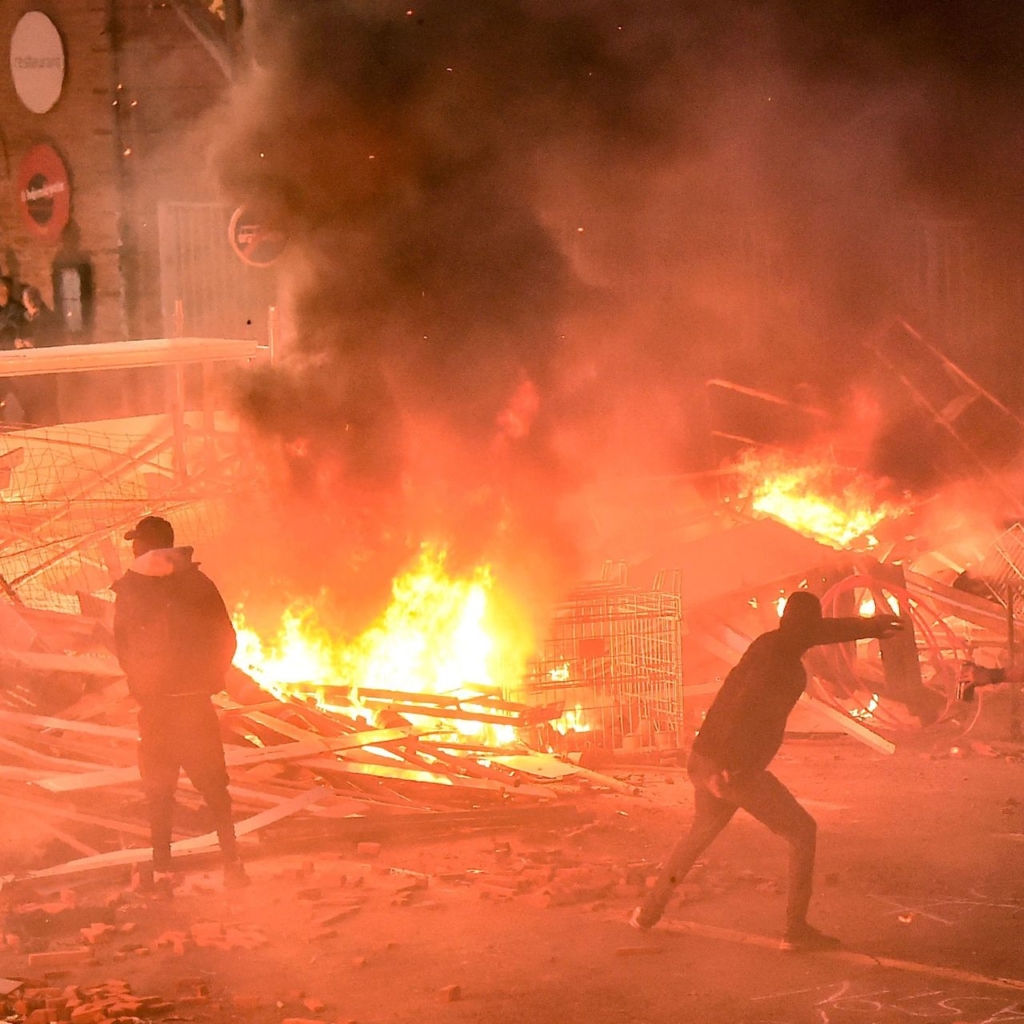
5. As concerns the insurrectional “acts” of November/December 2018, you write that we were “on the brink of a situation over which the authorities might in fact lose control.” That for the first time in a long time in France, the destitution of power appeared to be a “credible” perspective… in the end, what was lacking, to make this overthrow effective? And what lessons can be learned for the future from this critical moment?
In the early days of December, the ruling class genuinely feared a popular uprising, which is something that had not happened for quite some time in France. The full deployment of law enforcement was nearly overtaken and those in power half-heartedly admitted that the Macronian five-year period was on the line. When they were first heard only a few days prior, the calls to destitute the Head of State had still appeared as a sort of pious wish. In short, power seriously faltered.
One may of course wonder what the departure from Macron could have produced in the way of change. The destitution of a president is still a far cry from the destitution of state power as such. And this limitation is surely linked to the tendency to present this or that politician in particular as the principal enemy. It is true that the hatred that Macron magnetized served as useful fuel for the uprising, but we can only agree with those Yellow Vests who insisted early on that another president would do no better and, even more so, with those who pointed out that, once Macron leaves, he must not be replaced.
What was missing? What prevented the situation from tipping over completely? Some have suggested that it was the refusal of the central trade union organs to throw themselves into the fray. But could we expect anything other than a posture of suspicious distance from a movement that has so often presided over the decline of the very forms of organization they embody? A massive strike wave by the more combative trade union bases could certainly have been important. A broader alliance with the struggles of marginalized people from the hood, which has only seen furtive attempts, could certainly have changed the situation as well. By and large, it was one fraction of the working classes that rose up — the one rooted in the near hinterland zones that ring the major cities, who for the most part have regular jobs, own homes, and are by and large white. Of those segments of the larger working class who live in racialized neighborhoods, and more often victim to exclusion and precarity, only small numbers joined in the insurrection. In general, everything is done to ensure that these different segments of the working classes remain divided and even hostile toward each other, a process intensified by the sort of racism that invigorates the extreme right. From this point of view, the fact that so many in the Yellow Vest movement succeeded in rebuffing and rejecting the grip of racism and of the extreme right and, quite pointedly, avoided scapegoating “immigrant” or “migrants” is very encouraging, at least from the perspective of a broader rapprochement that might be possible down the road. The involvement of certain organs of neighborhood struggle is likewise a cause for optimism. But we are still far from the conditions that would really draw together the two halves of the working classes, beyond all that tends normally to divide them. Finally, the movement suffered the absence of certain more “militant” formations, whose mistrust of any movement in which the extreme right is presence tends to arouse mistrust, and critiques of “impurity,” being too-far removed from the forms of organization that their militant affiliation had accustomed them to consider legitimate.
Whatever else was found lacking, a powerful legacy is nonetheless being forged. It shows the kind of power that the sudden appearance of unforeseen popular mobilization can engender, even in the absence of any pre-existing logistical support networks common to the broader left or political groups. A new and widely shared perception of what can be done has emerged. The effect that this collective experience and shared perception of possibilities can have in subsequent uprisings should not be overlooked.

6. On a more strategic level, you take up some of the insights already offered in one of your previous books, Adieux au capitalisme (La Découverte, 2014). We agree that today the seizure of state power can no longer be a regulative aim of emancipatory politics, and that communism must be understood less as a horizon to be reached than as a process that unfolds in the present. The material foundations of such a process are what you call “liberated spaces,” that is, immediate forms of experimentation with a post- capitalist reality within the very heart of the contemporary world. There is a tendency, quite perilous from our point of view, to consider these liberated spaces as community refuges, harmless margins, in short to neglect their “antagonistic dimension,” thereby leaving the structures of domination intact. For this reason, we prefer to speak of instances of “counter-power” as a way of indicating a clearer connection between “building” and “fighting.“ How can we avoid this tendency to ghettoize liberated spaces (whatever their scale)? How can we preserve a link between prefigural positivity and the destructive function?
Exactly. What I call “liberated spaces” [espaces liberés] should not be construed as protected islands, where it we live out a charming life in the midst of the surrounding disaster, but as spaces for combat. “Free space” implies that we must free ourselves from something, from what oppresses us or causes us to slowly die; it implies that there is a struggle. In reality, these spaces are not entirely liberated, but only in the process of being so: they are not free of what oppresses and attacks them, nor consequently of the need to fight against them. At the same time as they are building from now on a different, clean reality, escaping as much as possible the norms of the economic world, they also have an intrinsically antagonistic dimension.
To affirm, as some do, that in order to exit capitalism it’s enough to simply stop reproducing it, without having to face off with it, is to ignore the antagonistic dimension of what could also be described as an interstitial strategy of openings. And I would add that the theories of collapse, at least in the version offered to us by “collapsology,” seem to me to induce a movement of flight, sometimes with panicked feeling, to shelters where it would be a question of learning, individually or in small groups, to survive the disaster. In this sense, it seems to me that there is a fairly strong opposition — perhaps even a polarization destined to appear with increasing clarity in the years to come — between the perspective of the liberated spaces, heard in their antagonistic dimension, and the reactions that collapsology elicits in the face of an allegedly inevitable and already ongoing implosion.
Of course, liberated spaces can take very different natures and scales. The most modest and discreet of them, by no means contemptible on this account, probably come into less direct conflict with their systemic environment than those who reach a certain dimension and who, in their process of creating their own reality, are led more openly to flout the norms of commodity society, or even to engage in a process of secession from state institutions, as in the case of Zapatista autonomy. As for the liberated spaces linked to the fight against large, harmful and useless projects, these cannot help but enter into direct conflict with the forces that sustain the world of the Economy and find themselves immediately threatened from them.
That said, it is often the enemy who succeeds in reminding liberated spaces of their antagonistic character, by attacking them variously and forcing them to defend themselves. But this reminder of a defensive antagonism is not enough. To build and multiply liberated spaces is certainly a positive way to contribute to the emergence of a world free of capitalist tyranny. But we cannot conceal the fact that these spaces encounter considerable difficulties, not only on account of the attacks they weather, but also because of the spirals of division and internal disintegration that often undermine them from within. Under these conditions, it is reasonable to think that they can only prosper if a broader struggle is able to attack the power of capitalist synthesis. This is why a concern for the survival of liberated spaces should lead us not to withdraw into the process of their construction alone, but to link it up with the broader fight against the world of the Economy. The liberated spaces can then be designed as bases for building bridges to other struggles and intensifying the offensive against the enemy.
For example, we might develop strategy that combines the multiplication of liberated spaces with generalizing blockades. To the extent that the liberated spaces are capable of deploying their own material resources and technical capacities, they can serve as decisive nodes on the basis of which it becomes possible to amplify the blockade dynamics at key moments, in various forms. The more liberated space we have, the more we should be able to extend our capacity for blockades. Conversely, the more widespread the blockades become, the more they promote the emergence of new liberated spaces.
Another dimension of such a strategy consists in deepening of links between existing liberated spaces. This is an important point, the urgency of which is no doubt widely felt, but on which too little progress has been made. Taking up an idea already launched earlier, the Zapatistas have proposed in a communiqué this past August to resume discussions surrounding the creation of a global network of resistance and rebellions. Numerous initiatives could and should exist that move in this same direction, and it would certainly be valuable if the various rebel territories could meet more closely, get to know each other better and exchange proposals, experiences, and concrete forms of mutual support for one another. In any case, for the Zapatistas, it is clear that the creation of autonomy in their territories in Chiapas, however important it may be for the concrete lives of tens of thousands of people, is not an end in itself; it only makes sense in combination with a global struggle against what they have called the capitalist hydra. And that is why they have never stopped organizing international, or even “intergalactic” meetings…
7. A complementary question: if the liberated spaces multiply and carry with them a genuinely antagonistic potential, it is obvious, as you say, that “the rulers of the world and those who serve them will not hand over their privileges voluntarily.” There is therefore also a problem of self-defense and the disaggregation of the enemy’s forces. How can we envisage this today, given the militarization of policing and the development of law enforcement technologies?
We always come back to this point: liberated spaces are places of collective construction; but they must also be defended. The scale and radicality of the liberated spaces that we are capable of building is directly proportional to the collective power at our disposal — and in particular to the capacity for self- defense that we are able to bring into play. In this regard, it should be recalled that the construction of Zapatista autonomy would certainly not have been possible without the armed uprising of January 1, 1994. And even if autonomy has taken on a civil character and has developed by dissociating itself from the Zapatista political-military organization, it has probably only been able to persist until now because it has enjoyed the protection of weapons (the Zapatistas have renounced the offensive use of weapons, but have kept them for defensive purposes). More broadly, it must be noted that today, the two liberated territories that were able to push the construction of autonomy the furthest, Zapatista Chiapas and Kurdish Rojava, are both linked to contexts where armed struggle plays or has played a certain role.
It is not a question of advocating armed struggle – which is something that the Zapatistas have been careful not to do ever since their public appearance in 1994. But it does highlight the rather direct link between the size of the liberated spaces and the necessity of a capacity for self-defense. There are of course many forms of self-defense that do not involve the use of weapons. Many struggles are experimenting with this, as was seen, for example, on the ZAD in Notre-dame-des-landes during Operation César in 2012. But this implies a successful conjunction combining a broad capacity for mobilization, collective physical commitment, unrelenting determination to defend that which is we hold dear, tactical intelligence and inventiveness, and of course the material, logistical and technical resources that go with this. To be sure, the more the enemy increases the level of repression and the means placed at the service of “policing” and the extension of the world of the Economy, the more difficult it becomes to defend liberated spaces. There is no simple formula for these matters, but it is clear that there is no other option than to increase our collective strength on all the points I have just mentioned (and probably others still).
In conclusion, I should reiterate that we have been plunged into a structural crisis such that the capitalist system can reproduce itself only at the cost of ever-increasing difficulties for both us and for it – and, first and foremost, at the cost of ever-increasing ecological and human destruction. We can already foresee that the antagonism between the world of Economics — which has proven itself ready to do anything in its power to perpetuate itself, to feed the quantitative hypertrophy of value, and to preserve the privileges of a few — and liberated spaces marked by multiple and conjoint ruptures with the ongoing devastation is bound to intensify. If this wager is even minimally correct, it would probably be a good idea to begin getting ready for it.
Jérôme Baschet is a historian currently teaching at the Autonomous University of Chiapas in San Cristóbal de Las Casas. Author of several books on medieval history, he has also published Défaire la tyrannie du présent. Temporalités émergentes et futurs inédits (2018) et La Rébellion zapatiste (2019). His book on the Gilets Jaunes is out now: Une Juste colère. Interrompre la destruction du monde
Translated by Kieran Aaron
source: MetaMute
